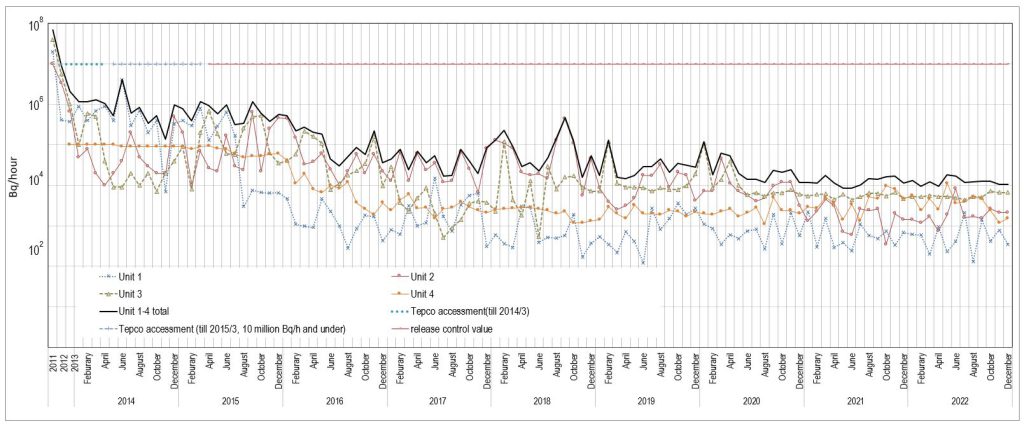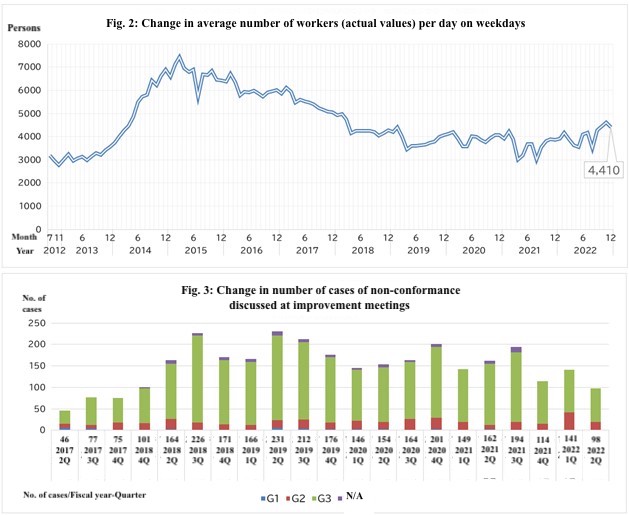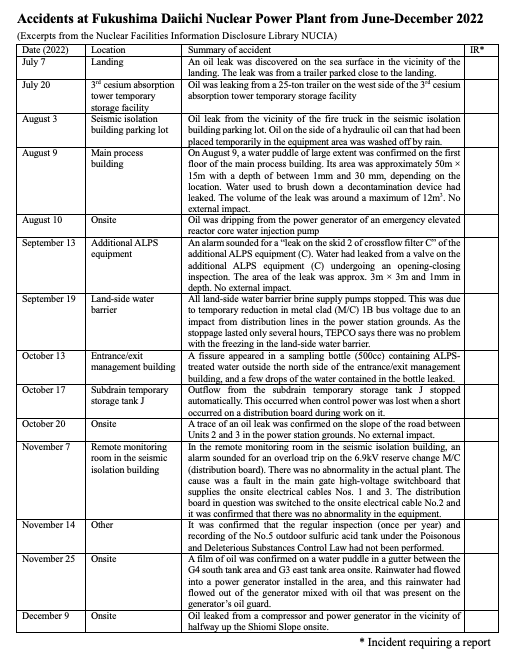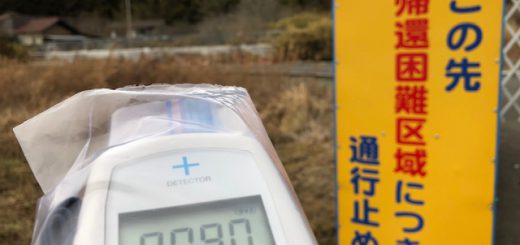Fukushima Now – Part 2
By Matsukubo Hajime (CNIC)
Current State of Post-Accident Operations at Fukushima Daiichi Nuclear Power Station (Jun. to Dec. 2022)
State of the Plant
The water temperature in the containment vessels and the spent fuel pools (SFPs) shows no great variation despite seasonal temperature changes. The state of releases of Xenon-135 (half-life roughly nine hours), released when uranium fuel undergoes fission, is also unchanged and it can therefore be estimated that the state of the reactors is stable. Further, according to an assessment by TEPCO in December 2022, around 10,000 becquerels per hour (Bq/h) of radioactive materials were being released to the atmosphere from the buildings (Fig.1).
Fig. 1. Radioactivity from Units 1 to 4 of Fukushima Daiichi Nuclear Power Station (Bq/h) released to the air
At the same time, decay heat has fallen greatly with the passage of time, and thus the volume of cooling water injected into the reactors has been reduced (falling from 7-10m3 per hour in May 2011 to 1.6-4m3 per hour as of December 2022).
The state of removal of spent nuclear fuel from the SFPs is summarized in Table 1. Spent nuclear fuel removal from Units 3 and 4 has been completed. However, as it has not been possible to remove control rods and other high-dose equipment stored in the SFPs, preparatory work has been underway for removal of this equipment from Unit 3 in the second half of FY2022 and removal from Unit 4 will commence in the second half of FY2024. Further, the removal of this equipment from Unit 3 was due to start from late October 2022, but this has now been rescheduled for early March 2023.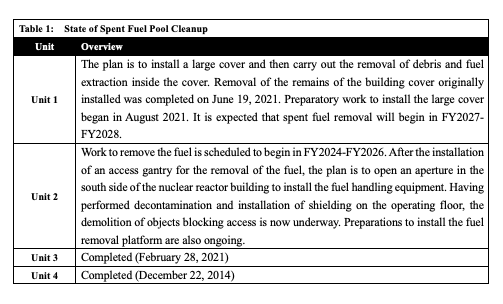
Preparations for the removal of fuel debris are also under way. The arrival of the device, developed in the UK, for experimental removal of debris from Unit 2 was delayed due to the spread of Covid-19, but arrived at the Naraha mockup facility in February. Removal tests are scheduled to be conducted during 2023. (This was originally scheduled for FY2021 in the Mid-term Roadmap.) Investigations are now underway in the Unit 1 reactor pressure containment vessel (PCV) and in the Unit 3 PCV and suppression chamber due to a water level drop.
The Unit 2 reactor core isolation cooling (RCIC) system was operating after the accident and for a further three days, including the time when the tsunami arrived at the plant. Uncovering the reason why it ceased functioning has been an issue, but it is inaccessible even now, after approximately 12 years underground. In December, however, as preparation for an investigation of the basement first floor, an investigation of triangular corners in the northwest and southwest of basement first floor was conducted. A maximum air dose rate of approximately 230 mSv/h was measured in both cases. (The floor area of the basement first floor is around 2,500m2).
The changes in the average number of workers onsite per day is shown in Fig. 2. As of December 2022, the number of workers was 4,410, about half the number it was at its peak. Changes in the number of cases of work non-conformance (work states that differ from the states originally intended or acts or judgements that differ from those that should have been taken) up to September 2022 are shown in Fig.3, as reported on the TEPCO website.
State of Contaminated Water
Contaminated water countermeasures at Fukushima Daiichi Nuclear Power Station (FDNPS) can be broadly divided into three areas: 1) Reduction of groundwater flowing into buildings, 2) Reduction of contaminated water flowing into the sea, and 3) Reduction of the toxicity of contaminated water. The main countermeasures to reduce water inflow into the buildings are, from higher elevations downward, (A) Pumping up groundwater at the groundwater bypass and releasing it into the sea (800,413m3 up to February 17, 2023), B) Installation of a frozen earth barrier (on-land water barrier, total length roughly 1,500m) surrounding FDNPS Units 1-4. C) Pumping up water at the subdrains and releasing it into the sea (1,465,922m3 up to February 16), and D) Paving of the site with asphalt to suppress permeation of rainwater into the soil. Measures to prevent the discharge of contaminated water into the ocean include A) Groundwater leakage prevention by a steel water barrier on the sea side, B) Pumping up of groundwater dammed up behind the sea-side water barrier from the well points and groundwater drains. Due to these measures, the volume of contaminated water that was 490m3/day in FY2015 fell to 130m3/day in FY2021. In FY2022, as there were no intensive rainstorms, it seems that the volume has fallen to below 100m3/day.
In the reduction of the toxicity of contaminated water, cesium and strontium are removed, and after the removal of impurities using a reverse osmosis (RO) membrane, radionuclides other than tritium are removed by the multi-radionuclide removal equipment (ALPS – Advanced Liquid Processing System) and then stored in tanks (containing 1,326,218m3 as of February 9, 2023. However, due to past equipment malfunctions and operational policies, in many cases radionuclides other than tritium are also present, resulting in only around 30% of the stored water being below the notification concentration). Besides this, roughly 11,360m3 of water remain in buildings, as well as 8,493m3 strontium-treated water, etc., 3,794m3 water treated by RO, and 9,401m3 concentrated wastewater, etc. that also exist onsite.
The frozen earth barrier consists of about 1600 30-meter freeze pipes buried in the ground, through which coolant at -30°C is circulated to freeze the surrounding soil. The effectiveness of the frozen earth barrier has been questioned since it was first installed, but since 2019 there have been several coolant leakage incidents.
Concerning the issue of releasing contaminated water into the ocean after ALPS treatment, TEPCO’s policy to release the water was authorized at the 25th Meeting of the Nuclear Regulatory Authority on July 22, and the construction was approved by the governor or Fukushima Prefecture and the mayors of both Okuma Town and Futaba Town in August. At present, construction of the release tunnel is ongoing, and the plan is to complete the construction during the first quarter of 2023. On January 13, the conference of the relevant ministers on the steady implementation of the basic policy on the disposal of the ALPS-treated water decided on the policy of “anticipating the timing of the actual oceanic release to be around spring to summer this year.” In combination with this, a fund of 50 billion yen has been created for fisheries. A fund of 30 billion yen has already been established as a measure against “adverse publicity.” Additionally, TV commercials, etc. are also being employed as “actions to foster understanding.” On the same day Chairman Masanobu Sakamoto of the National Federation of Fisheries Cooperative Associations released a statement saying, “We have not altered one little bit our opposition to the oceanic release.”
Meanwhile, Secretary General Henry Puna of the Pacific Islands Forum (PIF), an inter-governmental organization that aims to enhance cooperation among 15 countries and two regions of Oceania, announced in a statement on January 18 that PIF will demand a postponement of releases until it has become possible to confirm the safety of all involved. A PIF delegation that visited Japan on February 6-7 held talks with PM Kishida and others, agreeing to hold an intensive dialogue concerning the oceanic release. On February 10, a face-to-face briefing was organized by the Japanese government for the PIF secretariat and specialists.
